Google Calendar Has a Great Update for Hybrid Workers
Want your team to know where you are when you’re not in the office? We explain how Google Calendar’s new feature lets you share multiple work locations each day.
Want your team to know where you are when you’re not in the office? We explain how Google Calendar’s new feature lets you share multiple work locations each day.

For the benefit of our handhold scholars, we also extend our services on proposal writing, literature review writing, paper writing, and thesis writing. To sum up, we work as a one-stop solution to meet all your required research services. Further, connect with us to know more exciting details about our other services. In truth, we are good not only in recognizing current research issues/challenges but also smart enough to design corresponding fitting solutions. Since we keep developing several reliable solutions that create remarkable research contributions in the NLP field. This quality makes us unique from others and also lets our bonded scholars/students choose every time.
AI in Resume Review and ATS.
Posted: Tue, 12 Sep 2023 14:53:16 GMT [source]
Also, regular content audits and competitor analysis are equally effective in building and optimizing your content strategy. In turn, this means that regardless of your type of business, the opportunities to find new clients online are limitless. NLP can help you better handle customer queries by using bots to collect data about their website visitors and better reach them. They can help you identify customers ready to complete a purchase and pass those “hot leads” over to your sales team.
A large amount of content on different social networks can be treated with NLP to classify what is important and streamline processes. Launched in February 2022, Google’s predictive search feature People Search Next aims to anticipate future queries users will type into the search bar. Here instead of going one by one, it goes as a whole and produces more accurate results.
NLP is widely used in healthcare as a tool for making predictions of possible diseases. NLP algorithms can provide doctors with information concerning progressing illnesses such as depression or schizophrenia by interpreting speech patterns. Medical records are a tremendous source of information, and practitioners use NLP to detect diseases, improve the understanding of patients, facilitate care delivery, and cut costs. Google utilises this technology to provide you with the best possible results. With the introduction of BERT in 2019, Google has considerably improved intent detection and context. This is especially useful for voice search, as the queries entered that way are usually far more conversational and natural.
This step makes our experts to bringing new ideas, applications, methodologies
and algorithms. Our experts are bringing quality of
being novel ideas in the particular research https://www.metadialog.com/ area. It can be only determined by after
thorough literature search (state-of-the-art works published in IEEE, Springer, Elsevier,
ACM, ScienceDirect, Inderscience, and so on).
Before choosing a pre-trained model, it is important to understand the task at hand and the type of data involved. Different NLP tasks require different types of pre-trained models. For example, a pre-trained model for sentiment analysis may not be suitable for text generation.
Through this, one can enhance the existing models by simple integration of NLP Project Ideas. From a computer science viewpoint, NLP is a technique to enhance language processing and analysis tasks. The main of NLP is to provide accurate solutions for text translation and uncertainty problems. Further, it also includes several research areas that have widespread research problems best nlp algorithms and challenges. Deep Learning has evolved as the leading artificial intelligence paradigm over the past decade providing us with the ability to learn complex functions from raw data at unprecedented accuracy and scale. Deep Learning has been applied to problems in object recognition, speech recognition, speech synthesis, forecasting, scientific computing, control, and many more.
In order to understand how Google’s algorithm has been evolving over time, one must always consider user experience. To the Mountain View firm, the aim is always to ensure the satisfaction of those Internet users who rely on its search engine by offering them results that are as relevant as possible. This implies that they are continuously improving the quality of the pages highlighted in the SERP. Companies can also use natural language processing to help filter out resumes when recruiting talent.
Before paper writing, we collect reliable resources such as 50+ journal papers, magazines, news, encyclopedia (books), benchmark datasets, and online resources. On knowing the importance of these areas, we have designed innovative project ideas from a different perception of the NLP field. Once making contact with us, we are ready to share our recently collected NLP project ideas. Following are famous algorithms used in implementing NLP Project ideas for research work.
Whereas NLP is mainly concerned with converting unstructured language input into structured data, NLU is concerned with interpreting and understanding language. The grammar and context are also taken into account so that the speaker’s intention becomes clear. NLU uses AI algorithms (artificial intelligence algorithms) for the purpose best nlp algorithms of natural language processing in AI. These algorithms can perform statistical analyses and then recognise similarities in the text that has not yet been analysed. These bots are able to quickly and efficiently solve many customer issues because the algorithms are able to understand human language and respond appropriately.

NLP also helps you analyse the behaviour and habits of your potential customers according to their search queries. This enables you to scale more easily and tailor your messaging accordingly. It is important to understand why it is a right to explain automated decision-making.
Before choosing a pre-trained model, it is important to understand the task at hand and the type of data involved. Different NLP tasks require different types of pre-trained models. For example, a pre-trained model for sentiment analysis may not be suitable for text generation.
Over the last few decades, technology has been a driving force in business transformation and doesn’t show any signs of slowing down. The fact that direct digital transformation investments are projected to total $7 trillion between 2020 and 2023 demonstrates this.1 If you want your firm to succeed, you must have the appropriate technologies to help you keep up with the changing business world. Let’s take a look at the tech trend predictions for 2022.
In the present scenario, your technology must enable you to overcome three recent pandemic-induced issues:
In 2021, supply chain interruptions cost businesses throughout the world an average of $184 million.2
In September 2021, 4.4 million people resigned from their jobs in the United States alone, setting a new record.3
Ransomware affected 68.5% of businesses in 2021.4
Businesses must keep up with the demands of the evolving technology landscape if they wish to achieve their goals and remain competitive despite the changes brought about by the pandemic.
Track the latest technological trends to know if you are moving in the right direction. Having a managed service provider (MSP) on your side allows your business to stay up to date without you having to do much heavy lifting.
In 2022, third parties will be involved in 60% of security incidents. This means that firms that fail to invest in the risk management trifecta of people, processes, and technology may face cyberattacks.
Proactive businesses will include risk assessment, supply chain mapping, real-time risk intelligence, and business continuity management in their IT stack (rather than a single application like Excel).
To successfully and securely empower remote workers, organizations need to deliver:
However, a third of the companies still lag in these areas.
Cloud customers will change their business strategy to be completely cloud-native rather than using the cloud for only a portion of their portfolio.
Also, cloud-native adoption is predicted to reach 50% of enterprise organizations by 2022, spanning all major technology domains such as big data, artificial intelligence, and the Internet of Things.
In 2022, technology executives will concentrate on fixing long-term problems. The best will embrace a customer-centric approach to technology, allowing their organization to quickly reconfigure business structures and capabilities to meet future customer and employee needs with adaptability, innovation, and resilience.
If you are in NYC or Long Island and want to get your technology infrastructure ready for a successful year, you’ll need the help of a dependable managed service provider (MSP). Feel free to contact us to set up a free consultation. Our expertise and skillsets may be precisely what your company needs to help remote workers thrive.
Sources:
These days, it seems that half of the online business management revolves around cybersecurity, and for good reason. Malware attacks and ransomware threats are expensive, time-consuming, and can even lead to bankruptcy in isolated scenarios.
Indeed, there are several costly ransomware threats to business that enterprise executives may be unaware of. Let’s break down some of these threats in detail so you can grasp the full danger that even a single successful ransomware attack may pose to your company.
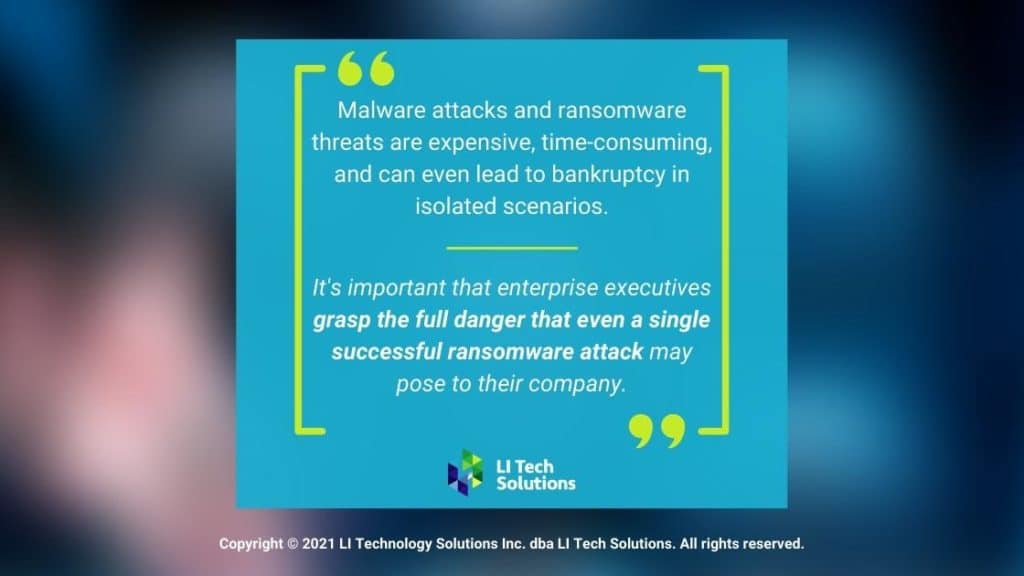
Naturally, any ransomware attack will include a ransom payment by its very nature. Most ransomware attacks are unreported and many enterprises are advised not to accept any demands. But plenty of firms do so regardless. Some estimates indicate that average ransomware payouts are over $300,000.
Some enterprises may have no choice when paying a ransom fee. If sensitive company data is on the line, they might not have enough time to come up with an alternative solution if they want to prevent sensitive information from leaking to the public. This could include customers’ credit card numbers or other identifying information.
In this way, ransomware attacks may cost a business money twice: first when the business pays the ransom fee, and another time when the business repairs any damage done by an attack.
Read more in our blog: 4 Dangerous Ransomware Attacks Proven False
In addition to the cost of the ransom payment, ransomware also typically costs companies thousands of dollars at minimum from disruption and downtime. When a company’s website or database goes down, it impacts its customers, their operations, and more.
In short, it tanks productivity and may have downstream effects for weeks, months, or even years to come. The cost of downtime is sometimes estimated to be much higher than the cost of even the most exorbitant ransom demands.
For example, an international currency exchange named Travelex was attacked by ransomware. The costs of disruption were so great that the company later had to file for bankruptcy.
Downtime to company services or websites costs more than money as well. Many online consumers don’t have any patience for websites that crash. In this way, companies may lose cash that they would otherwise receive as revenue when their customers go to their competitors or stop patronizing their online establishments.

In this day and age, enterprises that do online or international business must be very careful about their data security. Not only is it important for their operations, but it’s also crucial for the safety and security of their customers.
Data loss can take a heavy financial toll on ransomware attack victims. Some estimates indicate that 90% of ransomware attack victims don’t get all their data back, even if they pay the ransom fee.
If customer data is compromised, it can also lead to legal injunctions, particularly in light of legislation like the GDPR and CCPA. These fees can be quite exorbitant, just like ransom demands themselves.
Even after fees are paid, companies may be forced to undertake additional cybersecurity practices, adjust their procedures and policies, and implement other expensive fixes by legal mandate. All of those requirements can add up quite quickly, especially if a company’s security was subpar beforehand.
All told, the complete cost of data loss and security breaches can’t be fully tallied. In some cases, companies may lose the trust of their customers so much that they have no choice but to go out of business.
Enterprises must also consider the costs for forensic investigations and recovery when tallying the total cost of a ransomware attack. No company wants to be hit by the same attack twice, which means in-depth investigations are always required.
It often means hiring detailed cyber forensics specialists, leveraging certain types of expensive software, or shutting down company operations for some time while the investigation proceeds. Such adjustments may also cost the company in terms of productivity and customer loyalty, leading to further losses down the road.
Furthermore, recovery efforts, even when disaster recovery or business continuity plans are in place, can still cost hundreds of thousands or millions of dollars. Depending on the quality of forensic equipment and processes used, the investigation alone can cost tens of thousands of dollars.
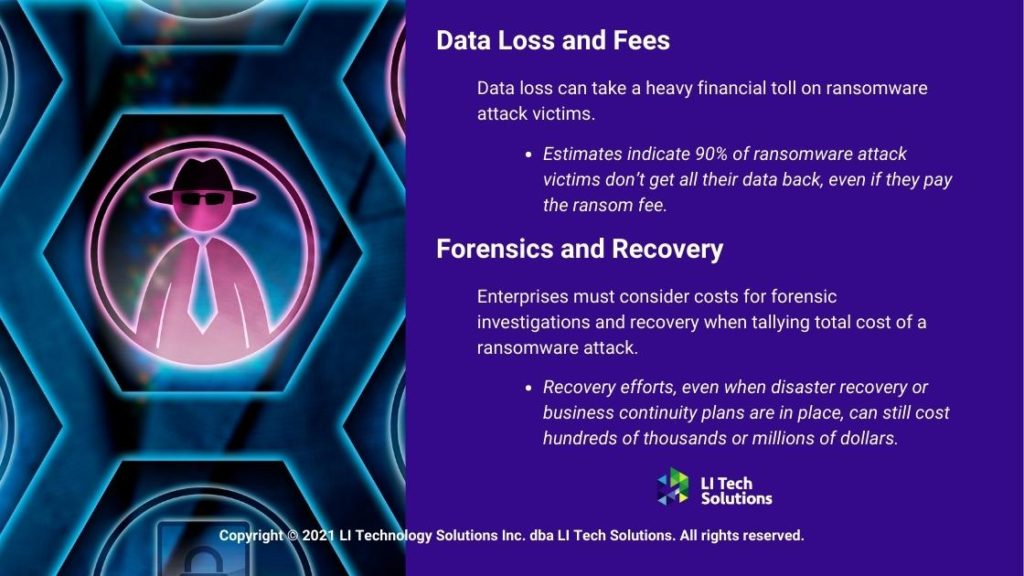
Some ransomware attacks incur additional costs in the form of broken or damaged infrastructure, such as decimated servers, irreparable platforms, and more. On top of that, you’ll have to purchase or rent infrastructure to recover after a ransomware attack, costing you more money in the short term.
Furthermore, in the immediate aftermath of a ransomware attack, many companies find that their cybersecurity insurance premiums have skyrocketed. They may choose to purchase additional infrastructure and security measures to prevent the same attack from happening again.
All these factors don’t even touch the potential reputational losses an enterprise may face when they are the victim of a ransomware attack. Even a single attack is enough to shatter the public’s perception of a company being safe and secure, especially if the public stores a lot of sensitive financial or personal information on their servers.
International customers, B2B clients, and other involved parties may simply stop doing business with an enterprise if they discover that it was the victim of a preventable ransomware attack. Even if the attack wasn’t preventable or was novel, the reputational losses are often impossible to stem.

Ultimately, no company wants to be the victim of a ransomware attack. That’s why high-quality IT security and managed IT services are more important than ever before.
When it comes to IT security in Long Island, look no further than LI TECH. As experienced data protection specialists, we offer a number of cloud management services, ranging from data protection cloud services to cloud infrastructure services and more.
We follow all the cybersecurity best practices for securing a cloud environment and put the safety and peace of mind of our clients at the forefront of each operation. Contact us today for more information.
The cloud computing revolution has just begun, but it’s already driven major changes in industries ranging from tech to finance to healthcare and more. This article covers five of the biggest benefits of cloud computing for your business.
Despite its widespread adoption, some companies still haven’t transitioned to cloud computing. Often this is because they don’t understand how they could be benefiting from this new way of storing, retrieving, and using data.
Still not sure how your business could benefit from cloud computing? Find out the advantages of working with a cloud computing service today and the benefits it brings.
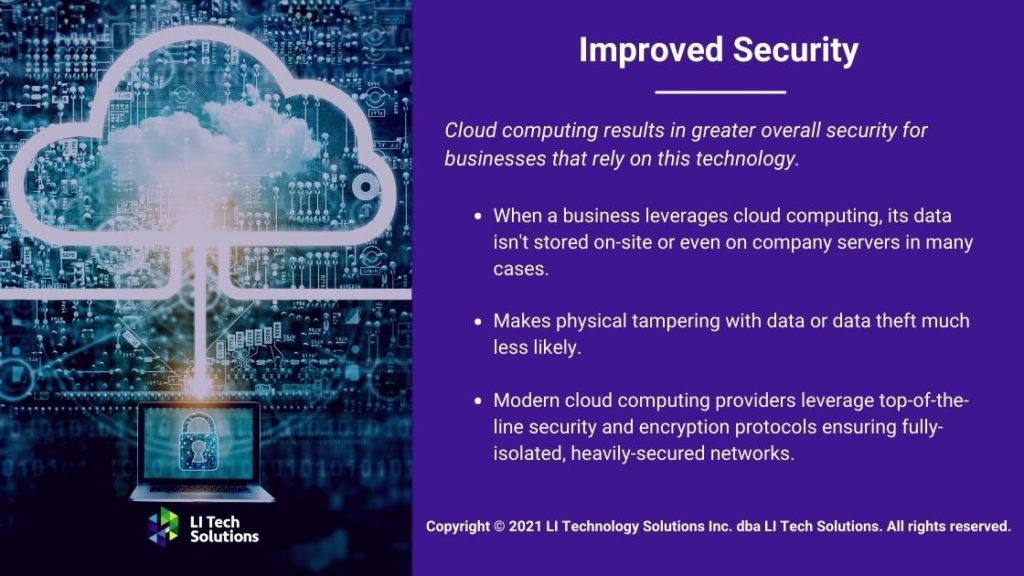
Perhaps the most important benefit overall is boosted security. This is especially crucial due to the modern legal requirements facing international companies (see below).
When a business leverages cloud computing, its data isn’t stored on-site or even on company servers in many cases. Instead, it’s stored on cloud servers hundreds or thousands of miles away.
This increases security because it makes physical tampering with data or data theft much less likely. For example, a business that uses cloud computing for data storage or processing isn’t at risk of a disgruntled employee using a stolen ID card to access and wipe company servers.
Furthermore, modern cloud computing providers leverage top-of-the-line security and encryption protocols to ensure that their networks are fully isolated, heavily secured, and include redundancy protocols.
These benefits of cloud computing for your business result in greater overall security for businesses that rely on this technology.
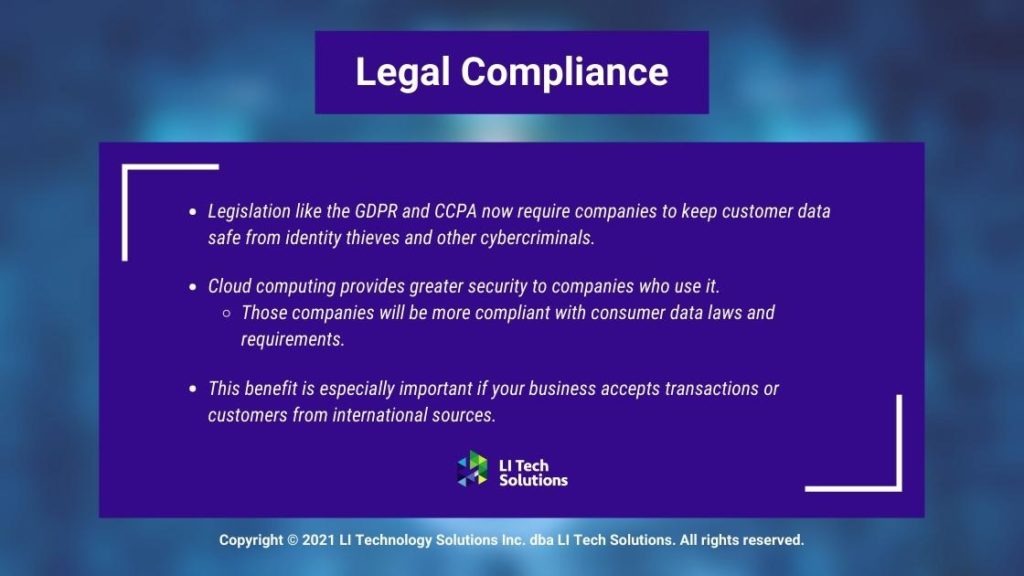
As touched on above, the modern legal environment is evolving quite fast. Legislation like the GDPR and CCPA now require companies to keep customer data safe from identity thieves and other cybercriminals.
Companies’ abilities to do this are directly affected by their overall security. A low-security company may be the victim of one or more cyber breaches. This causes their customer data to leak onto the wider web.
This may lead to excessive fines, loss of customer trust, and other major fallout from a single bad firewall or unprotected password.
In contrast, cloud computing provides greater security to companies who use it. Those companies will be more compliant with consumer data laws and requirements.
This benefit is especially important if your business accepts transactions or customers from international sources. Even in the US, legislation like the CCPA could become commonplace across states, making increased security a requirement rather than an optional inclusion.
Cloud computing offers a major practical benefit for businesses: faster and easier updates or setups for computer systems.
Cloud service providers address automatic updates, maintenance, and setup needs for their servers, software, and other products. That’s less work that a company has to do and fewer hours you have to dedicate to these tasks.
On top of that, cloud computing providers are continually improving structure with software development and hardware upgrades. They do this to maintain a competitive edge against other cloud service providers.
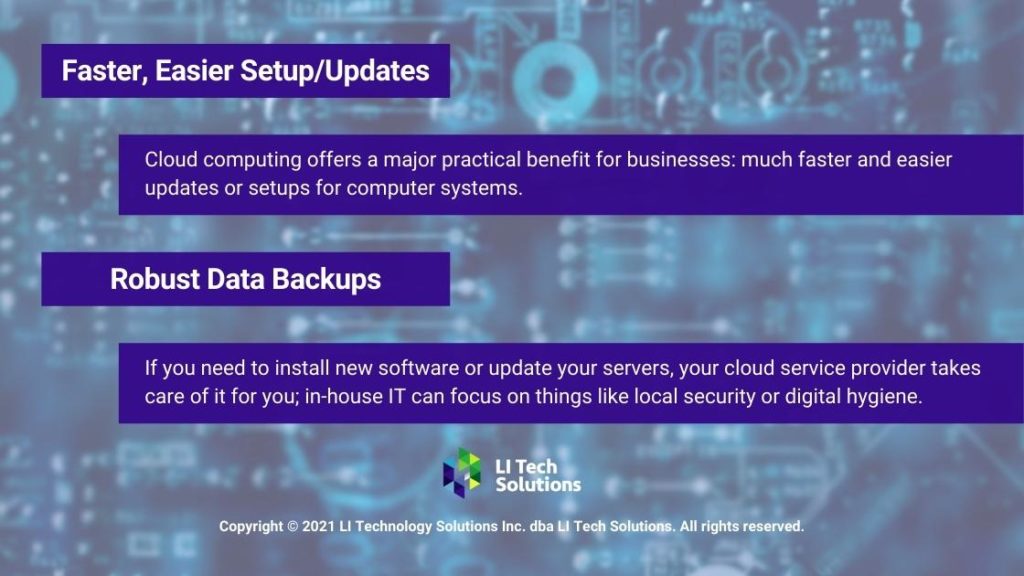
But your business benefits from this competition. If you need to install new software or update your servers, your cloud service provider takes care of all of it for you. Your in-house IT team can focus on other aspects like local security or digital hygiene with your employees.
This benefit is present even if you use hybrid cloud setups, which include private and public clouds. These cloud setups provide on-demand services but are also much easier to update, especially regarding security patches and new software functions.
Even the best servers may crash from time to time, and the second-worst thing after having your website crash is having all of your data wiped at the same time.
Cloud computing provides a convenient solution to this possibility: remote data backups that occur on a weekly or daily basis. You won’t have to take care of these data backups because your cloud service provider will do it for you.
These data backups ensure that, even if your site does crash (either because of a glitch or because of a targeted attack), you’ll be able to get it back up and running more quickly than average. Furthermore, you won’t lose sensitive data to the ether.
Automatic backups are absolutely a necessity for any company that collects customer data for their marketing or other purposes. With cloud computing, you don’t need to worry about having physical backups on-site; remote backups will always be available around the world.
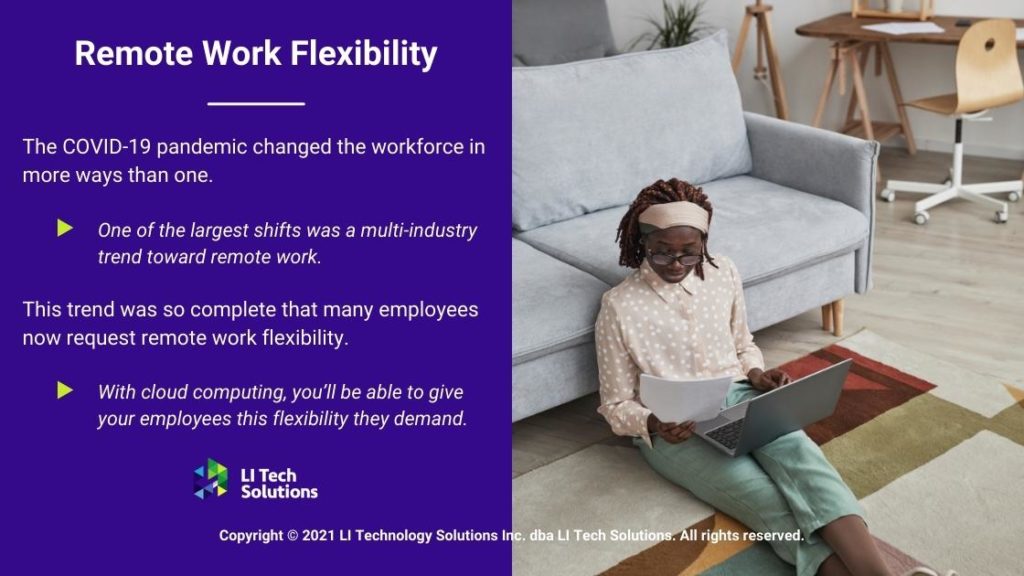
Cloud computing may benefit your business because of how it lends itself to remote work and schedule flexibility.
The COVID-19 pandemic changed the workforce in more ways than one. But one of the largest shifts was a multi-industry trend toward remote work, particularly for white-collar professions.
This trend was so complete that many employees now request remote work flexibility, even if they can technically return to office environments.
With cloud computing, you’ll be able to give your employees this flexibility they demand without having to compromise on tasks or production quotas.
Cloud computing allows employees and administrators alike to access sensitive company data through encrypted channels anywhere in the world with an Internet connection. Your employees can do just as much work at their homes or elsewhere as they could in your office.
While this improves the morale of your employees, it may also save on costs. Some companies are even transitioning out of large office complexes in favor of smaller or coworking spaces since no one uses the traditional spaces they pay for.
In the end, cloud computing is simply too advantageous for businesses for you to ignore.
Fortunately, your business can start enjoying the benefits of cloud computing with providers like LI TECH. We offer four different types of cloud computing services, ranging from private clouds to public clouds and more.
We provide a variety of cloud computing services and utilities to give your staff members ultimate flexibility, security, and productivity. Contact us today for more information.
Although ransomware has long been a serious concern for business owners all over the world, the COVID-19 pandemic has created new opportunities for this threat to flourish, and the attack vector is likely to become even more dangerous in the coming years. We discuss the need for additional backup to tackle ransomware.
According to a report, 304 million ransomware attacks occurred globally in 2020, with ransomware affecting over 65% of global businesses. Experts suggest that this is only the tip of the iceberg. Unfortunately, even though SMBs continue to be disproportionately affected by these nefarious attacks, reporting and notifications rarely make the news.
When it comes to cybersecurity and ransomware, the biggest mistake SMBs make is assuming hackers only target large enterprises. This is why many SMBs still rely on simple backups and don’t have a solid ransomware backup strategy in place.
The truth is that hackers are counting on smaller businesses to have fewer security measures in place, making it easier for them to get into your systems. While it’s good to have a data backup, it’s high time you take its security a step further.
4 Dangerous Ransomware Myths Proven False
This is an industry best practice for reducing the risk of losing data in the event of a breach. The 3-2-1 strategy involves having at least three copies of your data, two on-site but on different mediums/devices, and one off-site. Let’s examine each of the three elements and the issues they address:
Having at least two additional copies of your data, in addition to your original data, is ideal. This ensures that, in the event of a disaster, you will always have additional copies. The first backup copy of data is usually kept in the same physical location as the original, if not the same physical server.
Storing additional copies of your valuable data on the same server/location won’t be helpful in the event of a breach. Keep two copies of your data on different types of storage mediums such as internal hard drives, and removable storage like an external hard drive or a USB drive. If this isn’t practical for your business, keep copies on two internal hard disks in separate storage locations.
Keep one copy of your data off-site, far from the rest. This helps safeguard against worst-case scenarios.
In addition to the 3-2-1 backup strategy, consider applying the concept of layered security to keep your data and backup copies secure.
Most SMBs have an antivirus or firewall installed, but this is usually insufficient to combat today’s sophisticated threat landscape, necessitating the application of a layered security approach.
Because no security technology or measure is flawless or guaranteed, layered security assumes that attackers will infiltrate different layers of an organization’s defenses or have already done so. The goal of this approach is to provide multiple security measures so that if an attack gets past one security tool, there are others in place to help identify and stop the attack before your data is stolen.
The THREE ELEMENTS of layered security are:
Security policies, controls, and processes should all be devised and implemented during the PREVENTION phase.
The goal of DETECTION is to discover and notify a compromise as soon as possible.
A quick RESPONSE is crucial for the detection phase to be meaningful.
Layered security is divided into seven layers by security experts. Hackers seeking to get into a system must break through each layer to gain access. If you want to keep cybercriminals out of your systems, concentrate on improving these seven layers:
1. Information security policies
Implement security policies that restrict unauthorized access because the security and well-being of IT resources are dependent on them. This will help you raise information security awareness inside your organization and demonstrate to your clientele that you’re serious about securing their data.
2. Physical security
Physical security measures, such as fences and cameras, are critical to prevent unwanted intruders from breaking in. It also helps monitor employees with access to sensitive systems.
3. Network security
All it takes is for hackers to exploit a single vulnerability to get access to a company’s network. They can easily break into computers and servers after they’ve gained access to your network. Therefore, establishing effective network security measures is essential.
4. Vulnerability scanning
Vulnerabilities that occur because of factors such as inadequate patch management and misconfigurations open the door for cybercriminals. However, vulnerability scans help detect these missed patches and improper configurations.
5. Strong identity and access management (IAM)
Because of technological advancements, acquiring passwords and hacking into networks is easier than ever. IAM restricts access to critical data and applications to certain workers, making unauthorized access hard.
6. Proactive protection and reactive backup + recovery
Proactive protection detects and fixes security risks before they lead to a full-blown breach. The goal of reactive backup and recovery is to recover quickly after an attack.
7. Continual monitoring and testing
Failure to regularly monitor and test your backup and disaster recovery strategy is a major oversight and can result in a breach.
While it’s your responsibility to make sure your business doesn’t get sucked into the quicksand of data loss, it’s easy to become overwhelmed if you’re attempting to figure out everything on your own. Working with data protection backup providers at LI Tech gives you the advantage of having experts on your side. We’ll make sure your backup and security postures are capable of tackling ransomware threats. Li Tech Solutions offers clients in Long Island and Brooklyn the mission-critical services every business needs to succeed. Reach out today to schedule a consultation.
In a nutshell, a proxy server is an “intermediate” server that stands between an original server and a destination server. When one computer sends information to another, that information may need to pass through a third server – the proxy server. This article covers what a proxy server is, how it works, and benefits it provides.
Most Internet traffic is routed through proxy servers (with very few exceptions). Individuals use their terminals to query other computers for information, and their requests and responses are sent through proxy servers.
But why use proxy servers if they’re just in-between two computers exchanging information? The majority of modern proxy servers do a lot more than simply traffic web requests or data, ranging from filtering web traffic to offering shared network connections to storing or caching data to improve network speeds.
In truth, individuals and organizations alike both benefit from proxy servers and they may occasionally decide to use proxy servers for specific purposes.
Each terminal connected to the Internet (including computers or mobile devices) has an IP or Internet protocol address. A given terminal’s IP address is essentially the “street address” of that terminal. The IP address allows other computers to find it and helps proxy servers send traffic to that terminal when needed.
For most Internet traffic flow, a proxy server is another computer connected to the Internet with its own unique IP address.
When a user sends a data request, the request goes to the proxy server. The proxy server then makes the data request on behalf of the original requester. When the responding terminal sends data back, the proxy server collects the data and sends it to the first computer.
Of course, proxy servers can make changes to the data they collect or store because they are in-between the beginning and end computers in data exchange. For example, proxy servers can change the IP addresses of originating terminals, encrypt data, and more.
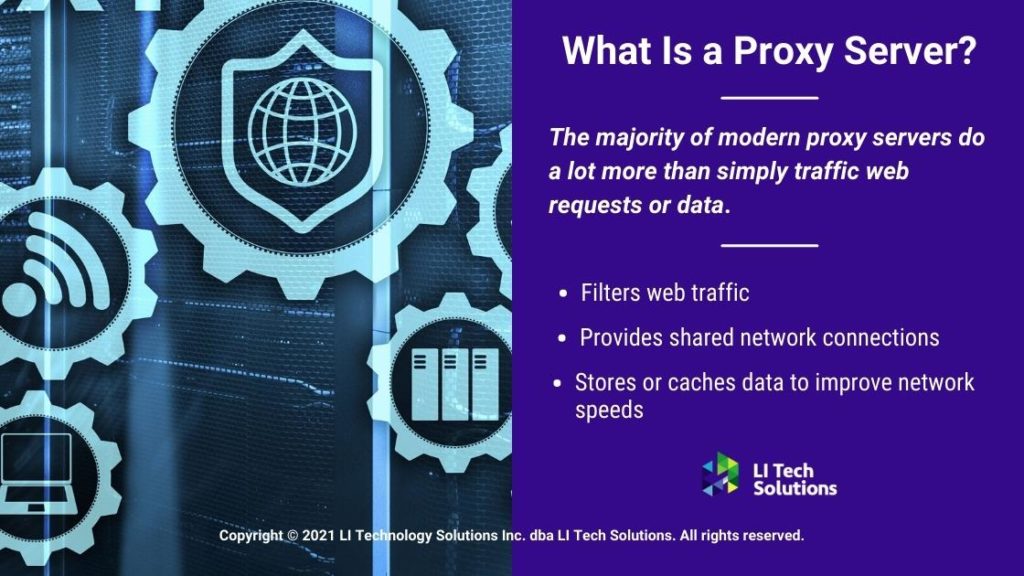
Proxy servers are useful in a variety of situations for both individuals and large organizations or enterprises.
Proxy servers may first and foremost improve loading speeds and bandwidth savings. By caching data for popular websites, such as Wikipedia or a company’s home site, the load time for those websites goes down.
Proxy servers can essentially save copies of frequently visited websites and only need to update the saved data occasionally. This, in turn, reduces network traffic and may lead to network performance improvements as well.
In some cases, this can save organizations time and money.
Proxy servers may also be used to monitor and control Internet usage. As the servers between originating terminals and recipient computers, proxy servers may allow:
This aspect of proxy servers is important for businesses, marketing agencies, parents, schools, and other institutions or individuals.
Proxy servers furthermore provide benefits for privacy and security. For example, individuals can use proxy servers to change their IP addresses so that other individuals or organizations can’t tell where their web requests came from. This is a form of identity protection and is a major part of VPN (virtual private network) security.
A VPN can protect identities by:
Additionally, companies and individuals alike can configure owned proxy servers to encrypt web requests. This may prevent malware sites from getting access to the proxy server, prevent spying or capturing of user traffic/data, and more.
Companies may also use proxy servers and VPNs for the same privacy benefits as described above. Proxy servers can protect employees from accidentally giving hackers or cyber criminals access to sensitive corporate information or passwords.
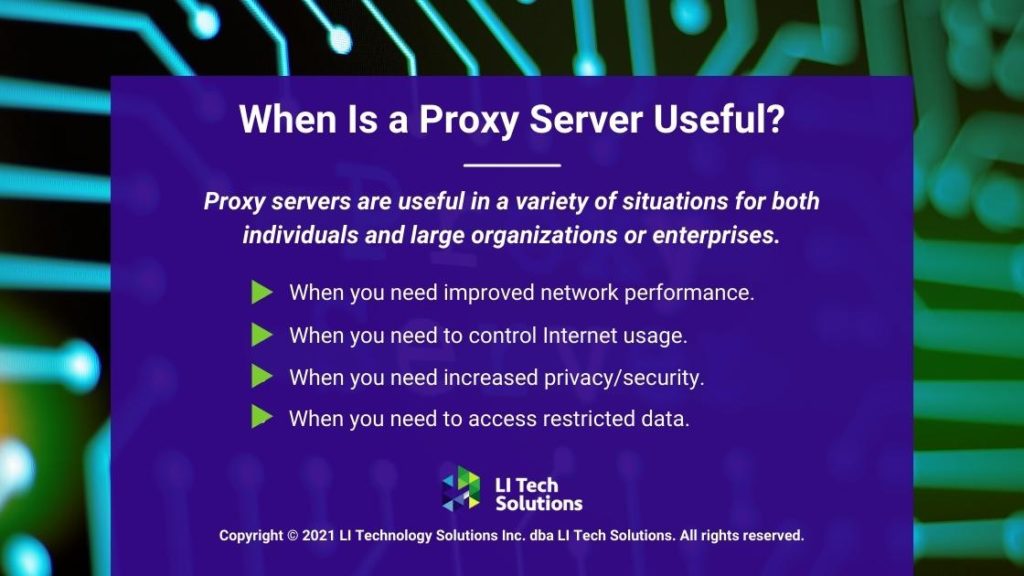
Lastly, proxy servers may allow users to access restricted or blocked resources. For example, an individual who wants to watch a TV show that is restricted in their country may be able to get around government firewalls by logging into a proxy server from another location.
When they query a recipient website for the TV show’s stream, they receive the data since it flows through the proxy server and never encounters the national firewall.
Thus, proxy servers are an important part of information freedom and allow citizens in restrictive countries access to more information or media than they would have otherwise.
In the end, proxy servers are an important part of the Internet overall and play a major role in all the web traffic that flows throughout the World Wide Web each day. In most cases, you never choose to use a proxy server intentionally.
But your organization may intentionally decide to leverage proxy servers for several of the advantages above, including increased security and better monitoring of your employees’ workplace habits.
Proxy servers can help you save money and make better use of company time by giving you more direct control over the traffic that flows to and from your company’s computers.
Fortunately, LI Tech Solutions can help you both set up and maintain proxy servers for the health of your organization and any other data or traffic-related goals you may have. As experts in data protection, server management, and more, we are well-equipped to help you benefit from proxy servers linked to your organization.
Contact us today for more information.
Cloud computing is revolutionizing every facet of healthcare services. HIPAA- compliant storage, applications, and varied networks worldwide are trending to the cloud, solving complex infrastructure issues and data protection solutions.
The fundamental premise of the cloud is to provide a computing model to enable ubiquitous, convenient, on-demand network access. The cloud is a shared pool of configurable computing resources (servers, networks, storage, applications, and proprietary services) that can be rapidly provisioned with minimal management or provider interaction.
Cloud compliance within the healthcare space continues to be identified as a pivotal facet for protecting patient data. Cloud innovation continues to evolve, and lax protection cannot be permitted. There is no resolution in sight to skyrocketing ransomware and malicious code attacks.
The following post highlights a few of the challenges and innovations healthcare organizations face in a world of increasing cloud adoption and rampant cyber-raids.
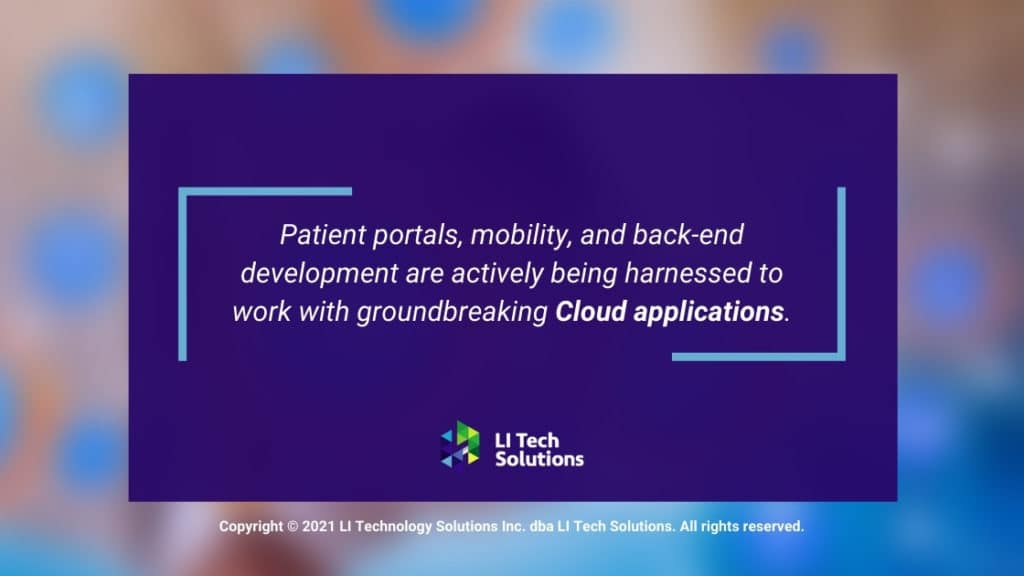
Varied healthcare industries ranked personalized care (52%) and AI assistants (44%) positively impacting cloud adoption. Patient portals, mobility, and back-end development are actively being harnessed to work with groundbreaking cloud applications.
LI Tech Solutions provides breakthrough Managed Services Support for Long Island and worldwide healthcare. LI Tech’s regulatory compliance division can equip your enterprise with proprietary hybrid cloud frameworks to mitigate any malware attack. (516) 210-6400
Healthcare cost restraints and data protection solutions rooted in the cloud are rapidly being implemented worldwide. Ransomware, service denials, and other malicious codes are proliferating more than ever before.
Streamlining Healthcare Data Management with Managed IT Services in Long Island
Millions of individuals are being affected by extortion-based ransomware attacks carried out against healthcare companies:
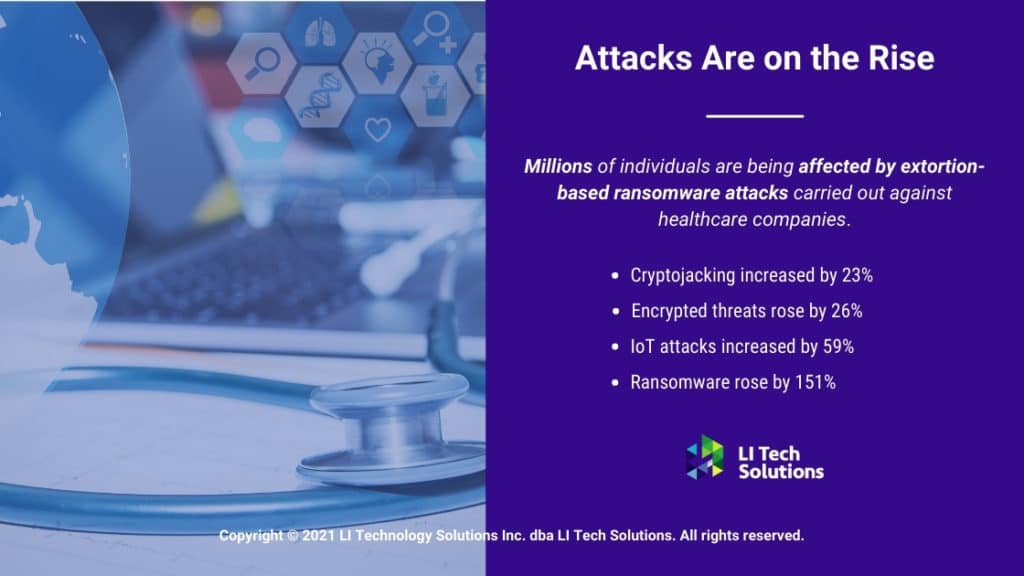
Attacks against healthcare continue to escalate. SonicWall gave its mid-year threat assessment. In just the first six months of 2021:
Healthcare organizations worldwide are under intensifying pressure to satisfy the mounting demands of patients and administrative compliance. Data security is a motivating factor for cloud deployment decisions by a majority of healthcare firms. Cost concerns placed a distant third.
Healthcare, across every industry vertical, must use care when implementing cloud-based solutions. The HIPAA Privacy Rule vigorously protects an individual’s information when dealing with any electronic activity.
HIPAA compliance requires healthcare systems to have appropriate physical, administrative, and technical safeguards protecting PHI and ePHI files.
Read more in our article: Healthcare’s Digital Transformation: Why It Matters
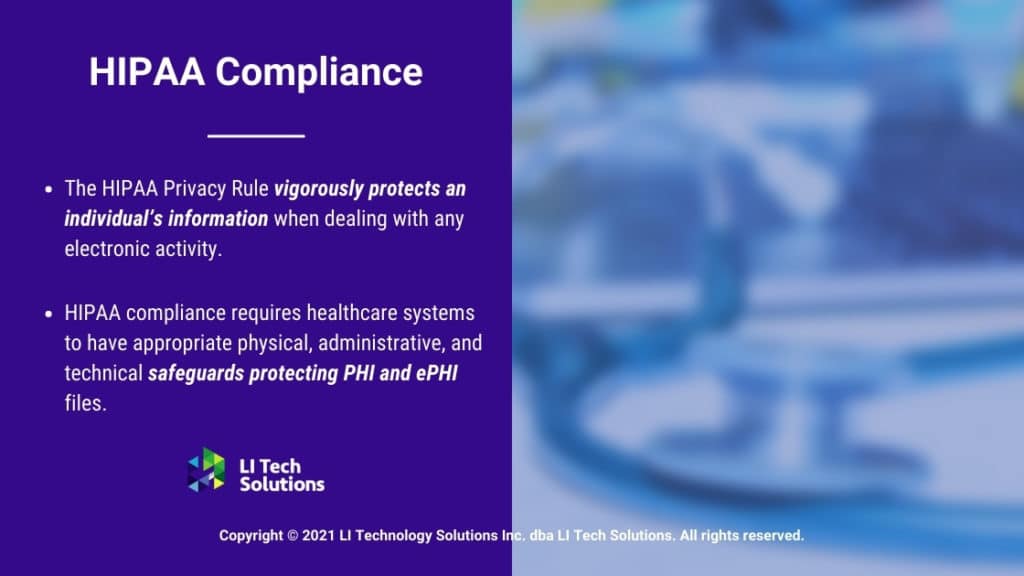
A substantial impediment to adopting cloud services is the treatment by HIPAA of external cloud partners. Healthcare Cloud vendors or subcontractors are compelled to secure an individual’s PHI to HIPAA standards. This element alone is intimidating to many smaller, under-resourced companies on the Cloud’s periphery.
The HIPAA Omnibus Rule is another fundamental safeguard of patient histories. Healthcare companies and their business associates/subcontractors must enter into a transaction agreement delineating the proposed uses of a patient’s personal healthcare information (PHI). If an associate runs afoul of the HIPAA law, the originating healthcare company can be held directly liable for the breach.
Technology functions differently in the healthcare space because of how electronic data is processed and stored.
HIPAA compliance in a world of accelerating advancements in cloud computing is a daunting task for every healthcare entity.
In 2014, NIST set a Cybersecurity framework for industries to establish cloud compliance within the HIPAA Rules and Regulations. Loopholes, uncovered by enterprising cyber-attackers, must be sealed with the help of determined American IT companies.
Framework Foundation:
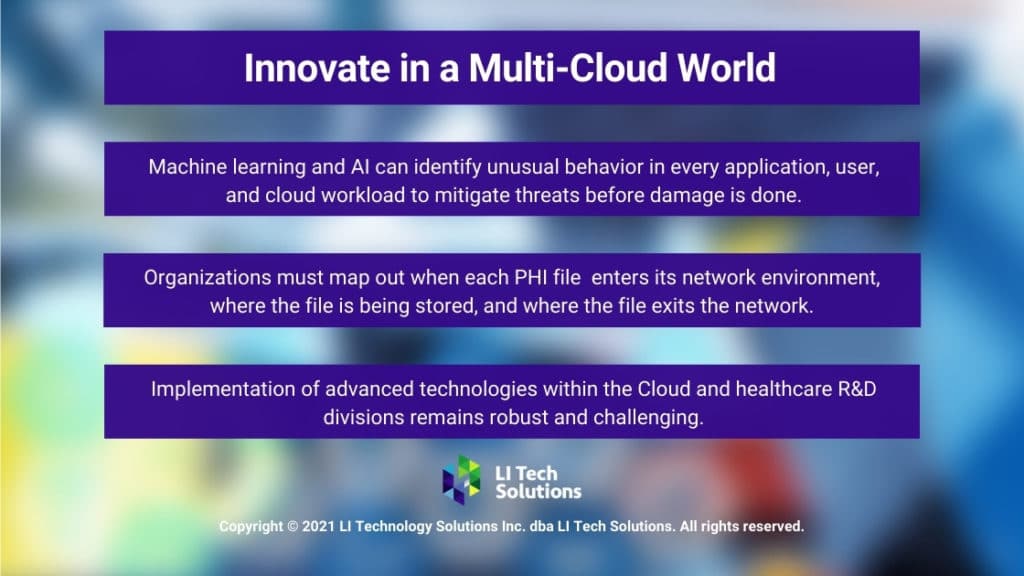
Healthcare is no longer a quaint little doctor sitting in a book-filled room, just down the street. Physician groups around the globe draw on the competence of countless other professionals connected to the unparalleled cloud foundation.
Regulatory frameworks, HIPAA, GDPR, and HITRUST, among other agencies, afford protection for various patient-critical environments. Healthcare continues its universal adoption of the cloud and its sophisticated technologies.
Multi-Cloud offerings and hybrid technologies offered by elite IT service companies, LI Tech Solutions, and others, innovate and leverage data in real-time.
Managed IT services for nonprofits are an emerging area of technology. LI Tech Solutions and other elite IT firms, offer powerful implementation and consulting of deep-dive cloud frameworks.
Machine learning and AI have become embedded in every facet of healthcare, providing powerful insights and network security. Unusual behavior can be identified in every application, user, and cloud workload to mitigate threats before damage is done.
Data encryption has developed into a strategic ingredient in a layered approach to patient care. Organizations must map out when each PHI file enters its network environment, where the file is being stored, and where the file exits the network.
HIPAA requires each healthcare company to encrypt and decrypt electronic health information for each of its patients. (ePHI)
HIPAA does not stipulate what degree of encryption is required for PHI files. However, best practice across the industry recommends AES-128, AES-256 or better.
Key segments of the healthcare sector continue to identify shifting models made up of multi-cloud structures and HIPAA compliance.
Implementation of advanced technologies within the cloud and healthcare R&D divisions remains robust and challenging.
When you run a business, compliance and cybersecurity are two essential factors. Both are equally important for the seamless operation of your business. While compliance helps your business stay within the limits of industry or government regulations, security protects the integrity of your business and sensitive data.
It is worth noting that although security is a prime component of compliance, compliance does not equal security. This is because compliance does not consider the growing threat landscape and associated risks. What it considers, however, is a set of pre-defined policies, procedures, controls, etc.
If an audit concludes that these pre-defined elements are adequate and your business adheres to them, everything is considered “okay” from a compliance standpoint. However, you still may not be up to scratch from a security standpoint, which only goes to show that you can be compliant but still fall short on security.
In other words, because compliance requirements take a predictable path and change slowly, the compliance landscape lags behind the rapidly changing, unpredictable security landscape.
Now, let’s find out how your business can benefit by combining compliance and cybersecurity.
Cybersecurity Solutions for Long Island Businesses: Managing Compliance and Mitigating Risks
There are multiple security loopholes that you must proactively fix to stay out of danger. You can do it by deploying suitable security solutions. A few common security loopholes and related solutions are:
APTs across three attack pillars — endpoints, network and the cloud — are capable of paralyzing hybrid/remote/on-site work environments. Experts estimate the global APT protection market to be worth close to $6 billion in 2021 and $12 billion in 2025.(1) This statistic highlights the trouble caused by APTs. The best way to tackle it is by deploying a solution that can:
Over the last two years, insider incidents have increased by 47%.(2) What makes the scenario even worse is the fact that insider threats are tough to detect. That’s why it is advisable to have an advanced internal threat detection solution that combines machine learning and intelligent tagging to identify anomalous activity, suspicious changes and threats caused by misconfiguration.
Keeping track of all the computers, mobile phones, printers and servers on your business’ network is challenging, especially in today’s increasingly remote-first approach to work. But without knowing the devices on your network, it is not possible to know your IT network’s health. To combat this problem, you need an automated assessment and documentation solution capable of identifying risks to all assets, including those not physically connected to the network.
Tackle all the above issues by deploying industry-best solutions for security awareness training, dark web monitoring and identity/access management.
Just like security loopholes, you must also fix compliance loopholes the moment you spot them. Non-compliance can even lead to regulators levying penalties as high as 4% of your company turnover.(4) Beyond financial loss, you will also have to face stakeholder dissatisfaction, drop in market share, etc. To avoid such trouble, use a solution that automates compliance processes and generates insightful reports that document compliance.
Long Island’s Best IT Company Offers MSP Data Protection & Recovery Tips
Most companies have at least minimum protection in place, such as an antivirus on workstations/active firewalls. However, you must make sure that your business’ security posture can withstand the growing cyberthreat landscape. With some effort, you can incorporate your security solutions into your compliance strategy as well.
By carefully bringing both security and compliance together systematically, you can reduce risks significantly. To ramp up your organization’s security posture, you can implement strong authentication, data protection, access monitoring, network-to-edge defenses, etc. By routinely validating the effectiveness of these solutions once they’re in place, you can ensure your organization is taking the necessary measures to avoid non-compliance and security breaches.
Ready to take the next step? We can help. Contact us today.
Register for a consultation to learn more about how LI Tech Solutions can help you combine compliance and cybersecurity to prevent data compliance issues.
Sources:
Complying with data privacy and protection regulations wouldn’t give several business owners sleepless nights if it only meant installing a predefined list of security solutions. Compliance goes way beyond this and for good reason. In principle, regulators, local or international, want businesses to:
Each of the above steps are mandatory and non-negotiable. A closer look will tell you that installing a list of expensive security solutions comes only after the first three steps in the process have been followed. Skipping past these initial steps and acting merely on presumptuous knowledge is tantamount to leaving your business’ future to sheer chance. It’s anyone’s guess what that would lead to.
That’s why we’re going to explain to you why a thorough and accurate risk assessment is truly the first step towards achieving compliance. Moreover, when repeated regularly, it can help you demonstrate continuous compliance while keeping cyberthreats at bay.
A thorough and accurate risk assessment can unearth a host of crucial insights from even the deepest and darkest alleys of your IT environment to ultimately empower your decision making. Having actionable insights at your disposal can help you build strategies to reduce risk levels in practical ways instead of shooting in the dark by testing various tools.
Here are some of the most important details that become more apparent and unambiguous with every risk assessment.
A risk assessment helps you chart out the lifecycle of all data that is collected, stored and managed in your entire network.
A meticulous risk assessment identifies all the possible threats, such as intentional, unintentional, technical, non-technical and structural, that your business data is exposed to.
With each assessment, you get the latest list of vulnerabilities prevalent in your network with respect to patches, policies, procedures, software, equipment and more.
From the assessment report, you can also understand the existing security and privacy controls protecting your business against vulnerabilities.
An accurate assessment report is fully capable of anticipating the probability of a threat that might exploit one of your network’s existing vulnerabilities.
Risk assessment also helps you gauge the possible impact of any threat hitting your business.
Imagine how easy it would be for you to build and implement a strategy to fix the security loopholes in your business while maintaining a well-documented record of your efforts.
While assessing whether you did everything in your capacity to ensure full compliance with the regulations, you also need to keep in mind that a regulator seeks evidence of compliance – documented reports. Besides helping you chart a successful path to compliance, a thorough risk assessment adds great weightage to demonstrating evidence of compliance. When you present the risk assessment reports along with other documentation, you demonstrate how your business carried out due diligence in upholding principles of data privacy and protection.
Please remember that no regulator expects you to have a fail-safe strategy. What matters is uncompromising intent, informed action and undeterred consistency. If you can demonstrate all this, you will most likely avoid any punitive action as well as a long list of problems could that surface afterwards.
Contrary to what is often claimed, there are no shortcuts to compliance or to any of the steps that lead to it. At the outset, achieving compliance might seem grueling. However, it isn’t as bad as it seems when due process and expert guidance is followed.
A conversation with us is all you need so we can help you walk through the complexities of risk assessment with diligent and customized guidance.
Article curated and used by permission.